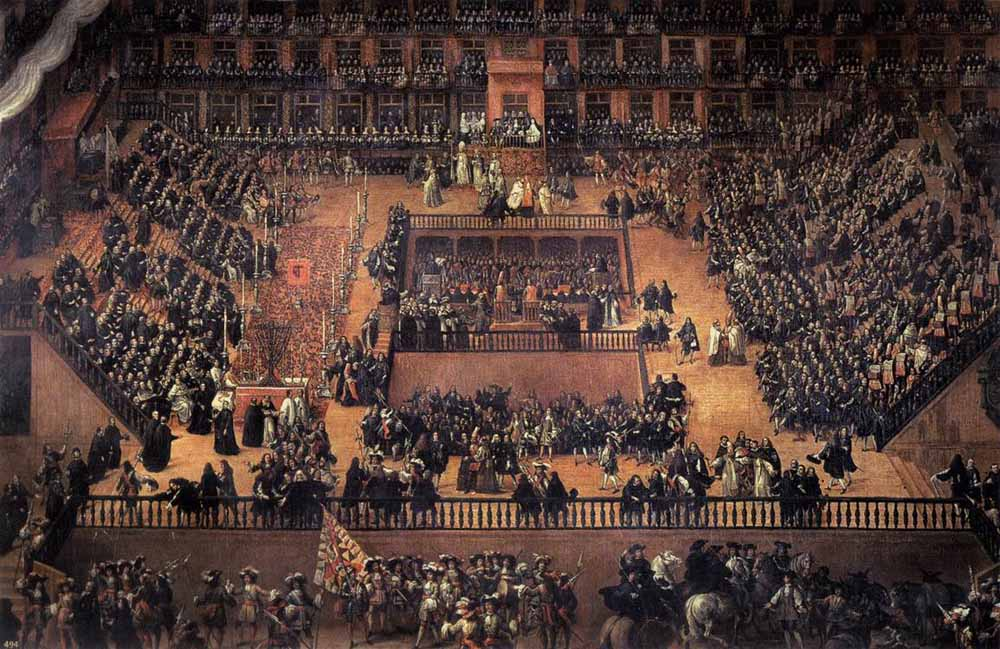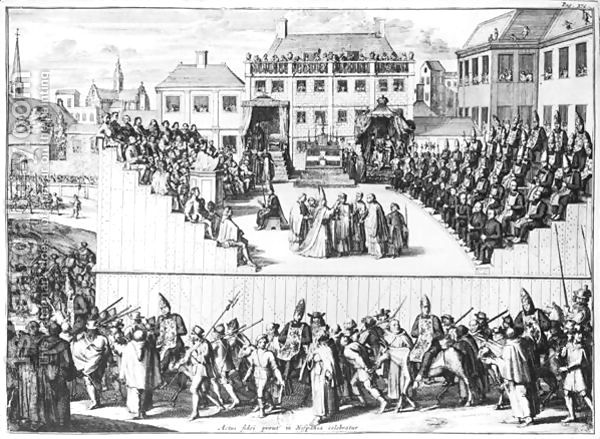The Spanish Inquisition has cast a long shadow in the public imagination, with Inquisitors playing the role of villain on stage and screen. But what was the Inquisition-really? Established in 1480 to deal with heresies under King Ferdinand and Queen Isabella, the Spanish Inquisition was a highly regulated institution with enormous political and legal power whose influence reached all the way to the Americas for over three hundred years.
Guest Miriam Bodian from UT’s Department of History separates truth from legend and reveals the intricacies of the Inquisition’s processes and inner workings.
Guests
 Mariam BodianProfessor in the Department of History and Director of the Institute for Historical Studies at the University of Texas at Austin
Mariam BodianProfessor in the Department of History and Director of the Institute for Historical Studies at the University of Texas at Austin
Hosts
 Joan NeubergerProfessor of History, University of Texas at Austin
Joan NeubergerProfessor of History, University of Texas at Austin
Can you tell us what the institution of the Spanish Inquisition was, when it was in operation, and in general what its purpose was?
The Inquisition was established in Spain in 1480 by King Ferdinand and Queen Isabella who are better known for having supported Christopher Columbus’s voyages to America. They came to power with a problem on their hands. Almost a century earlier, there had been mass riots throughout Spain during the summer of 1391, and many thousands of Jews were forcibly baptized. After they were baptized, they were expected to live as Christians, but many of them continued to practice Judaism as well as they could in secret. The Inquisition was designed to expose cases of what they called “Judaizing”–that is, reverse conversion to Judaism among these forced converts and their descendants–in order to purify Spain of this ‘heresy.’

How important was the Inquisition in early modern Spain? Was this something that everyone had contact with and knew about?
Yes. There is nothing that has ever appeared on stage or screen that has adequately conveyed the power of this enormous institution. Until it was abolished in 1834, it enjoyed the full support of the Spanish crown, it had 23 tribunals, including 3 in the Americas. An Inquisitor General stood at the center of its vast bureaucracy over inquisitors, prosecutors, comisarios, notaries, and other functionaries. It could call on a veritable army of familiares, or lay officials, who supplied information and aided the Inquisition in various ways. I should add that its power was greatly enhanced by its secrecy. This made fair trials from our point of view almost impossible. Once prisoners were admitted to the secret cells, as they were called, they had no contact with the outside world, although smuggling of information was not unknown, and, until formal charges were brought, they weren’t told why they were being held. Even afterward, the identity of the persons who had denounced them was withheld, and the accusations against them were worded to protect their identity. At least two denunciations were require to proceed to trial, but heresy evidence was entirely acceptable. So, the secrecy was one of the keys to both its power and the terror that it invoked.
And how did the Inquisition decide who to arrest? Did they randomly pick people up that they thought might be heretics, or were they careful about identifying who they thought might be enemies or heretics?
This is an area with a lot of misunderstanding. The Inquisition did not round up and immediately punish people. There were very exacting regulations that governed its activities, and they were very detailed. There is a huge mass of records of individual cases which have only begun to be explored, and they generally attest to the scrupulousness of the Inquisitors, notaries, and other officials in following these regulations. No one could be arrested without some kind of evidence of guilt in hand, so whatever evidence had been supplied (usually by denunciations) was examined and a vote was taken before the inquisition proceeded to arrest. After that, the suspect was imprisoned for the duration of the trial, but before charges were formally brought against him or her–and this could take months–the suspect appeared before the tribunal and was questioned and admonished, or warned. The suspect could confess at any point – that would shorten the trial and lighten the punishment. If he or she didn’t confess, at least fully, at the first audience, two more attempts would be made and then a formal accusation was made.
After the formal accusation, the inquisition gave the suspect an advocate. This was like a lawyer, but this lawyer was a paid functionary of the Inquisition, and it was really his job to try to get the prisoner to confess. Occasionally an advocate did act to defend the prisoner and try to ensure a fairer outcome, but for the most part they were there to secure a confession. Suspects could also name people who might testify on their behalf: a priest, a parish priest, or somebody with some social status that they knew. They could also name people that they felt might have denounced them unlawfully, for example: a neighbor with whom they quarreling or, very often, an angry servant. Sometimes they named an entire Rolodex of acquaintances, including family members, to exclude almost everyone from consideration as a sincere, honest denouncer.
So, the Inquisition had very specific rules and structures for accusing people. My assumption was that they targeted Jews in particular as heretics. Is that true?
Actually, the Inquisition didn’t prosecute Jews, at least not unbaptized Jews. It prosecuted religious crimes only if they were committed by what it termed heretics. By definition, a heretic had to be a baptized person–it was somebody who had deviated from orthodoxy after having been baptized into the Church. So, the Jews that the Inquisition targeted were what were called the conversos, often referred to in the Inquisition documents as “judios” or “judeos” in Portuguese, which is the word for Jew. They were descendants of Jews who had been forcibly baptized in Spain in and after 1391.
Did they ever target people who were not related to, or in some way descended from, Jews? Did they arrest people for witchcraft or sorcery?
They actually arrested people for all kinds of things once the Inquisition was in place. It tended to extend its authority rather than shrink it, as most institutions do. They prosecuted crypto-Muslims, bigamists, homosexuals. They prosecuted Old Christians for various crimes against the faith. The one thing they didn’t really prosecute against was witchcraft, and this is interesting because witches were tried in so many European lands as well as in New England. The Inquisitors tended to be very rationalistic and for the most part didn’t believe there was such a thing as witchcraft. So, there was really only one outstanding episode of witch hunting in the 350-odd years of the Inquisition’s existence. This took place in the north of Spain in the Kingdom of Navarre, from 1609-1611. In fact, most scholars agree that Spain was notably free of witch trials in comparison to the rest of Europe.
Did the Inquisition use torture on prisoners?
Well, yes. But not as much as most people think. It didn’t apply torture indiscriminately. Most prisoners were not tortured at all. Torture was highly regulated. It took a lot of manpower and it was time consuming. It was only applied for two reasons. A) to gain a confession from a prisoner who was reluctant to confess, or B), to gain information about other heretics, more names to prosecute. So, if the tribunal was satisfied that a prisoner, after being interrogated, had confessed and supplied the information that was wanted, and this happened frequently, then they wouldn’t call for torture. The elderly and the sick wouldn’t be tortured. Whenever torture was administered, a physician was expected to be present in order to suspend the proceedings if they felt that the prisoner’s life was in danger. So, it was not automatic, it was not indiscriminate, and it was actually much more regulated than torture in civil courts at this time.

The punishments that I associate with the Spanish Inquisition seem torturous. When I think of the Spanish Inquisition, I think of burning at the stake? Is that how most people were punished if they were found guilty?
Another misconception. Burning at the stake was certainly one of the possible punishments, but not by a long shot was every victim of the Inquisition burned at the stake. There were many other punishments. Some of them were severe, for example: public lashes, which could be humiliating as well as painful; further imprisonment; one of the worst was service in the galleys, that is working rowing in the galleys of ships. Some of them were lighter: it could be a mere reprimand by an Inquisitor, or a scolding, or taking a pledge to be loyal to the church. It could be paying a severe penalty, it could be exile from a town or a region for a specified period. Most prisoners who were tried were not burned at the stake. There’s a study of 44,000 cases–a little less than half the cases after 1540–out of those 44,674 cases, 824 were burned at the state. That’s still a lot of people, but it’s less than 2% of those arrested and tried and a lot less than most people think.
Were people ever found not guilty and released?
Actually, the Inquisition did not adhere to the principle that you’re innocent until proven guilty. The Inquisition would have considered it beneath its dignity to acquit a prisoner. When there was clearly not enough evidence, or the evidence pointed to the prisoner’s evidence, the Inquisition might suspend the case and the prisoner would have to live with the stigma of having been tried.
Having been released?
Yes, but he would have spent time in prison and there would have been stigma, or the Inquisition might have sentenced the prisoner to a very light sentence for suspicion.
Finally, how was all of this activity paid for?
The finances were very complex. The Inquisition was supported by the crown, but the tribunals were actually expected to be independently financed. One of the most important sources of revenue was property confiscated from prisoners. This is one of the most shocking aspects of these trials. At the moment of arrest, the prisoner’s property would have come under the administration of the Inquisition, all of it, in great detail. Pots and pans, goats, whatever. This was used to pay for the prisoner’s upkeep, their food, if they needed bedding. If prisoners had to be taken long distance under guard to the town where they would be tried, the expenses of travel would be paid for out of their property. Even in cases where prisoners would be tortured, the fee paid to the public executioner–the person who administered the torture–would be paid out of their own property.
And, if prisoners were found guilty of heresy, their property would be entirely confiscated, and this was one of the most important sources of income for the Inquisition.
Would you say that, in the end, the Spanish Inquisition was successful at what it set out to do?
Well, its goals changed. Let me put it this way: it was never entirely successful at suppressing non-conformist and heretical thinking of all sorts, but it was quite successful at suppressing the public expression of dissent. Spain really bypassed a whole era in the development of European thinking. It wasn’t hermetically sealed off, but through censorship, the Inquisition prevented the entry into Spain of publications that challenged the remaining orthodoxy as well.
When did it come to an end?
It came to an end slowly. It was sort of moribund by the Enlightenment, when some Spaniards were questioning the kind of “justice” that the Inquisition was dispensing. But it remained a fairly popular institution. It was abolished only with Napoleon’s invasion of Spain in 1808, when Napoleon set up a liberal regime. But when the French were driven out five years later, the Inquisition was re-established. It was only finally abolished in 1834, shockingly late.
Documents and Further Reading
An Account of the Expulsion from Spain
In the spring of 1492, shortly after the Moors were driven out of Granada, Ferdinand and Isabella of Spain expelled all the Jews from their lands and thus, by a stroke of the pen, put an end to the largest and most distinguished Jewish settlement in Europe. The expulsion of this intelligent, cultured, and industrious class was prompted only in part by the greed of the king and the intensified nationalism of the people who had just brought the crusade against the Muslim Moors to a glorious close. The real motive was the religious zeal of the Church, the Queen, and the masses. The official reason given for driving out the Jews was that they encouraged the Marranos to persist in their Jewishness and thus would not allow them to become good Christians. The following account gives a detailed and accurate picture of the expulsion and its immediate consequences for Spanish Jewry. It was written in Hebrew by an Italian Jew in April or May, 1495.
The Inquisition in 17th Century Peru: Cases of Portuguese “Judaizers”
From Henry C Lea, The Inquisition in the Spanish Dependencies (1909)
Truth About the Spanish Inquisition
CatholicCulture advertises this as an “accurate portrayal of the Spanish Inquisition by a contemporary American historian.” Political, cultural, religious and judicial aspects of the Inquisition are all addressed. The roles of both the Holy See and the Spanish Crown are described.